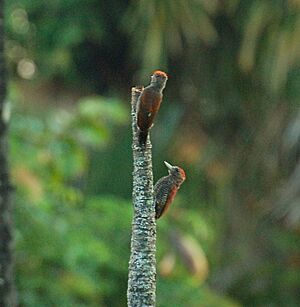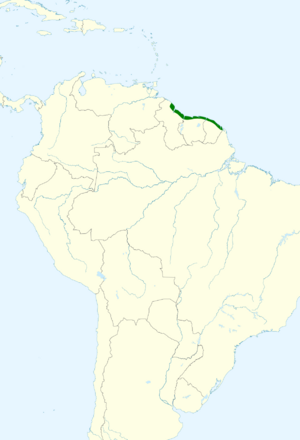Blood-colored woodpecker facts for kids
Quick facts for kids Blood-colored woodpecker |
|
|---|---|
 |
|
| Conservation status | |
| Scientific classification | |
| Genus: |
Veniliornis
|
| Species: |
sanguineus
|
 |
|
| Synonyms | |
|
Dryobates sanguineus |
|
The blood-colored woodpecker (Veniliornis sanguineus) is a cool type of bird that belongs to the woodpecker family. You can find these colorful birds in Guyana and Suriname, which are countries in South America.
Contents
Understanding the Blood-Colored Woodpecker
Scientists like to group animals together based on how they are related. This helps us understand them better! The blood-colored woodpecker is usually placed in a group called Veniliornis. But some scientists think it should be in a different group called Dryobates. It's like different ways of organizing a library! Everyone agrees that this woodpecker is a "monotypic" species. This means it's the only one of its kind in its specific group, without any different types.
What Does the Blood-Colored Woodpecker Look Like?
Imagine a bird about 13 centimeters (about 5 inches) long. It weighs between 23 and 30 grams (about 0.8 to 1 ounce). Male and female blood-colored woodpeckers look very similar, except for their heads. Both sexes have a mostly brown face.
- Males have a bright crimson-red color on top of their heads, from the crown to the back of the neck. You might see some brown feathers peeking through.
- Females have a brown crown with thin white tips on their feathers.
The upper parts of both sexes are a dark crimson-red. Their flight feathers are dark brown. The tail is also dark brown. Their undersides are dark brownish with off-white stripes all over. This bird has dark red-brown eyes and a dark gray beak with a lighter tip. Its legs are blackish. Young woodpeckers are usually duller and browner than the adults.
Where Do Blood-Colored Woodpeckers Live?
The blood-colored woodpecker lives in the coastal lowlands of Guyana and Suriname. It likes to live in places like mangrove forests and swamp forests. Sometimes, you might even find them in coffee plantations!
How Do Blood-Colored Woodpeckers Behave?
Movement and Home Life
The blood-colored woodpecker stays in its home area all year long. It does not migrate to other places.
What Do They Eat?
These woodpeckers look for food in trees and bushes. They usually search alone or in pairs. Their diet includes ants, beetles, and caterpillars. They use their strong beaks to find these insects.
How Do They Raise Their Young?
Blood-colored woodpeckers have been seen breeding in Suriname during different months of the year. Both the male and female work together to dig out a nest hole. They usually make this hole low to the ground in a tree stump or a branch. It can take up to two months to dig out the perfect nest! A female usually lays one or two eggs, but sometimes three. Both parents take turns sitting on the eggs to keep them warm (this is called incubating). They also both bring food to the baby birds in the nest and after they leave the nest. We don't know exactly how long it takes for the eggs to hatch or for the young birds to be ready to fly.
What Sounds Do They Make?
The most common sound the blood-colored woodpecker makes is a single "keek" note. It can also make a fast series of about 16 "wih" notes. Both male and female woodpeckers drum on trees. This is how they communicate and mark their territory.
Is the Blood-Colored Woodpecker Safe?
The IUCN (International Union for Conservation of Nature) has listed the blood-colored woodpecker as a species of "Least Concern." This means that it is not currently considered to be in danger of disappearing. Even though it lives in a small area, its population seems to be stable. No immediate threats have been found. However, losing their natural habitat (like mangroves and swamps) could become a problem in the future.


